

*Art Tutorial~How To Draw/Sketch Human Body & Pose* on Pinterest. CARTOON FUNDAMENTALS. How to Draw Facial Expressions to Show Emotion. In this Quick Tip I will be showing some useful guidelines you can follow to create the base of a head with facial features, following that up with quick tips on how to shape the facial features to create an expression/show emotion!
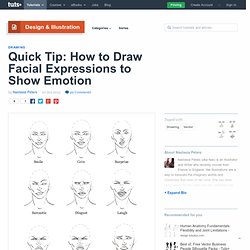
We will start by creating a base shape of the head before focusing on the expressions. How to Draw Different Body Types for Males and Females. Last month we talked about how to draw different expressions and emotions.

In this tutorial I will be showing you useful guidelines you can follow to draw common body types for both males and females. We will be using simple shapes to draw the body type out over it, such as rectangles, triangles and irregular quadrilaterals. We will start out with six female body types and then follow that up with six male body types. Step 1: Body Base: Height and Shoulder Width. Cartoon Fundamentals: Create Emotions From Simple Changes in the Face.
There are millions of eyes, mouths, noses, ears, chins in the world, each with their own characteristics.

However, to draw faces in a cartoon style, you just need to understand the basics of them. Once you have mastered these concepts, pay attention to the depth, make sure that the head of your characters give the impression of being three-dimensional and you have mastered the technique of drawing them from every imaginable angle. Cartoon Fundamentals: The Secrets in Drawing Animals. Knowing how to draw faces and facial expressions is a basic item in the toolbox of any cartoonist.

But your journey will not be complete until you can also draw the giant animal world! Here, in much larger intensity of human-beings, diversity dominates! We have birds, fish, pets, wild animals... each animal with their unique characteristics. It seems difficult to represent so many features with just a paper and a pencil, right? Well, for today I'll prove it's easier than you think. Drawing cartoons is very rewarding. But the child's world is not complete without animals. How to Draw a Long Haired Character Portrait With Color Pencils. In this tutorial, I would like to show you how to draw and color long hair using a mechanical pencil and color pencils.

Grab you tools now, it's time to draw! Tools Mechanical pencil 2B pencil leads Faber Castell Classic Color Pencils No: 309 – Royal Yellow, 314 – Orange, 318 – Red, 392 – Fire Brick, 388 – Brown, 321 – ScarletEraserPaper: any type 1. Human Anatomy Fundamentals: Basic Body Proportions. If you’ve practiced capturing energy in the previous tutorial, you’ll have acquired a good feel for loose sketching of people.
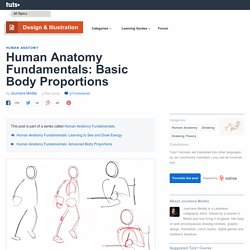
We’re going to start giving structure to that feeling-based groundwork by studying the body with a more scientific eye. Let me say that it will take many sessions to cover the wonders of the human body. Not only is it among the most sophisticated animal structures in nature, it is also one of those with most variations: few other species come in so many shapes and colors. Nobody, therefore, should feel frustrated for having trouble drawing people; it is an ambitious undertaking. We’re going to build up this skill from the ground up, in the same order as a drawing process, starting with a simplified skeleton (the basic figure or stick figure), moving on to the volumes of muscle structure, and then finally the details of each part of the body and face. Let’s assume this figure is standing with feet vertically aligned with the hip joints. We’re done... almost. Human Anatomy Fundamentals: Advanced Body Proportions – Tuts+ Tutorials.
In our last session we learned the basic, generic proportions and joint alignments of the human figure, and if you've been practicing you should be ready for some diversity. The most obvious differentiation may be between men and women, but an illustrator must also be familiar with the ways the body also changes according to age (while it is still growing) and type. Male vs. Female Proportions Male and female proportions are so different that even a skeleton (or certain parts of it) betrays its sex. Bear in mind, however, that on a vertical axis there is no real difference: the joints don't move up or down.
The Shoulders/Hips Ratio The primary difference is the relationship of shoulder width to hips. Cartoon Fundamentals: How to Draw Cartoon Hands. Human Anatomy Fundamentals: Balance and Movement – Design & Illustration – Tuts+ Tutorials. This is our last session working with the basic structure of the body before we start clothing it in flesh.

We have seen how it is proportioned and how those proportions vary within limits; now we'll see how it counters gravity with posture – and how far posture can be pushed before it falls over (or, on paper, looks out of balance). The body's Center of Gravity (CoG) is roughly behind the belly button. Cartoon Fundamentals: How to Draw the Female Form. Design.tutsplus. Elephants are a one of a kind - there's no other animal with such amazing tusks and trunk.
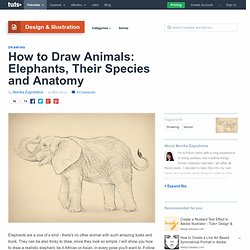
They can be also tricky to draw, since they look so simple. I will show you how to draw a realistic elephant, be it African or Asian, in every pose you'll want to. Follow me and I'll teach you all elephant things! When we look at an elephant skeleton, we can see it's unproportional and somewhat clumsy, big head, long legs and bulgy barrow. Legs, unlike other animals, are very straight and are what makes an elephant similar to a human. Sketch the initial pose for your elephant using the second scheme. The contours of an elephant muscles are faded by thick skin, so there's no need to learn them all. There are two species of elephant: African elephant and Asian elephant. African elephants have a wide, Africa-shaped ears. Now you can sketch your pose and body. To draw an elephant head in a profile view you can follow the instruction below. There's another difference coming from both species and sex. Design.tutsplus. Three point perspective is great when you wish to render objects or scenes from an abnormally high or low point of view.
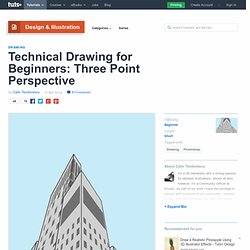
The distortions that the third vanishing point brings into your composition often has a very artistic effect and makes even the most simple concept more interesting. There are some points to consider when working in three point perspective. Human Anatomy Fundamentals: Basics of The Face. Having thoroughly explored the human body, it is time to start looking more closely at its details, starting with the face.
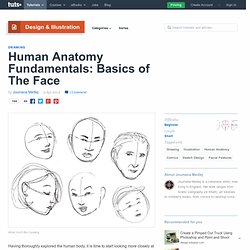
The very first thing the eye looks for, in any setting, is the human face, and this applies also to art: a viewer will first look at the face of your character. Mastering the face, particularly the drawing of lively expressive faces, is therefore well worth the effort. In this tutorial we're learning the basics of the face – proportions, features and foreshortening, and we'll go into the details of facial variations in our next session. The skull is a slightly flattened sphere, to which the jaw is appended so that, seen face-on, it has the shape of an egg, pointy side down.
Two perpendicular midlines cut the egg into four quarters. Cartoon Fundamentals: How to Draw a Cartoon Face Correctly. Home. Security Alert: